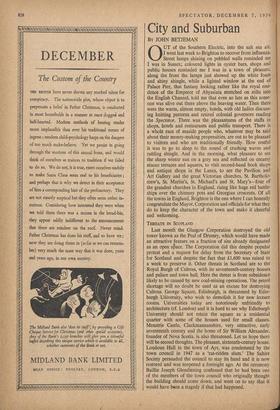City and Suburban
BY JOHN BETJEMAN UT of the Southern Electric, into the salt sea air, I went last week to Brighton to recover from influenza. Street lamps shining on pebbled walls reminded me I was in Sussex; coloured lights in oyster bars, shops and public houses reminded me I was in a town of pleasure; along the front the lamps just showed up the white foam and shiny shingle, while a lighted window at the end of Palace Pier, that fantasy looking. rather like the royal resi- dence of the Emperor of Abyssinia stretched on stilts into the English Channel, told me that even so late as this some- one was alive out there above the heaving water. Then there were the warm, almost empty, hotels, with old ladies discuss- ing knitting patterns and retired colonial governors reading the Spectator. There was the pleasantness of the staffs in shops, hotels and restaurants and public transport. There is a whole race of seaside people who, whatever may be said about their money-making propensities, are out to be pleasant to visitors and who are traditionally friendly. How restful it was to go to sleep to the sound of crashing waves and rattling shingle. And in the morning, what pleasure to sec the sharp winter sun on a grey sea and reflected on creamy stucco terraces and squares, to visit second-hand book shops and antique shops in the Lanes, to see the Pavilion and Art Gallery and the great Victorian churches, St. Bartholo- mew's, St. Martin's, St. Michael's and St. Mary's—four of the grandest churches in England, rising like huge red battle- ships over the chimney pots and Georgian crescents. Of all the towns in England, Brighton is the one where 1 can honestly congratulate the Mayor, Corporation and officials for what they do to keep the character of the town and make it cheerful and welcoming.
THREATS IN SCOTLAND Last month the Glasgow Corporation destroyed the old tower known as the Peal of Drumry, which would have made an attractive feature on a fraction of site already designated as an open s$ace. The Corporation did this despite popular protest and a request for delay from the Secretary of Stale for Scotland and despite the fact that £1,600 was raised in a week to preserve it. Other threats in Scotland are to the Royal Burgh of Culross, with its seventeenth-century houses and palace and town hall. Here the threat is from subsidence likely to be caused by new coal-mining operations. The petrol shortage will no doubt be used as an excuse for destroying Culross. George Square, Edinburgh, is threatened by Edin- burgh University, who wish to demolish it for new lecture rooms. Universities today are notoriously unfriendly to architecture (cf. London) and it is hard to see why Edinburgh University should not retain the square as a residential quarter with some of the houses used for small classes. Menstrie Castle, Clackmannanshire, very attractive, early seventeenth century and the home of Sir William Alexander. founder of Nova Scotia, is also threatened. Let us hope there will be second thoughts. The pleasant, sixteenth-century house, Loudoun Hall in the town of Ayr, was condemned by the town council in 1947 as a 'rat-ridden slum.' The Saltire Society persuaded the council to stay its hand and it is now restored and was reopened a fortnight ago. At the ceremony Baillie Joseph Glendinning confessed that he had been one of the members of the town council who originally thought the building should come down, and went on to say that it would have been a tragedy if that had happened.


































 Previous page
Previous page